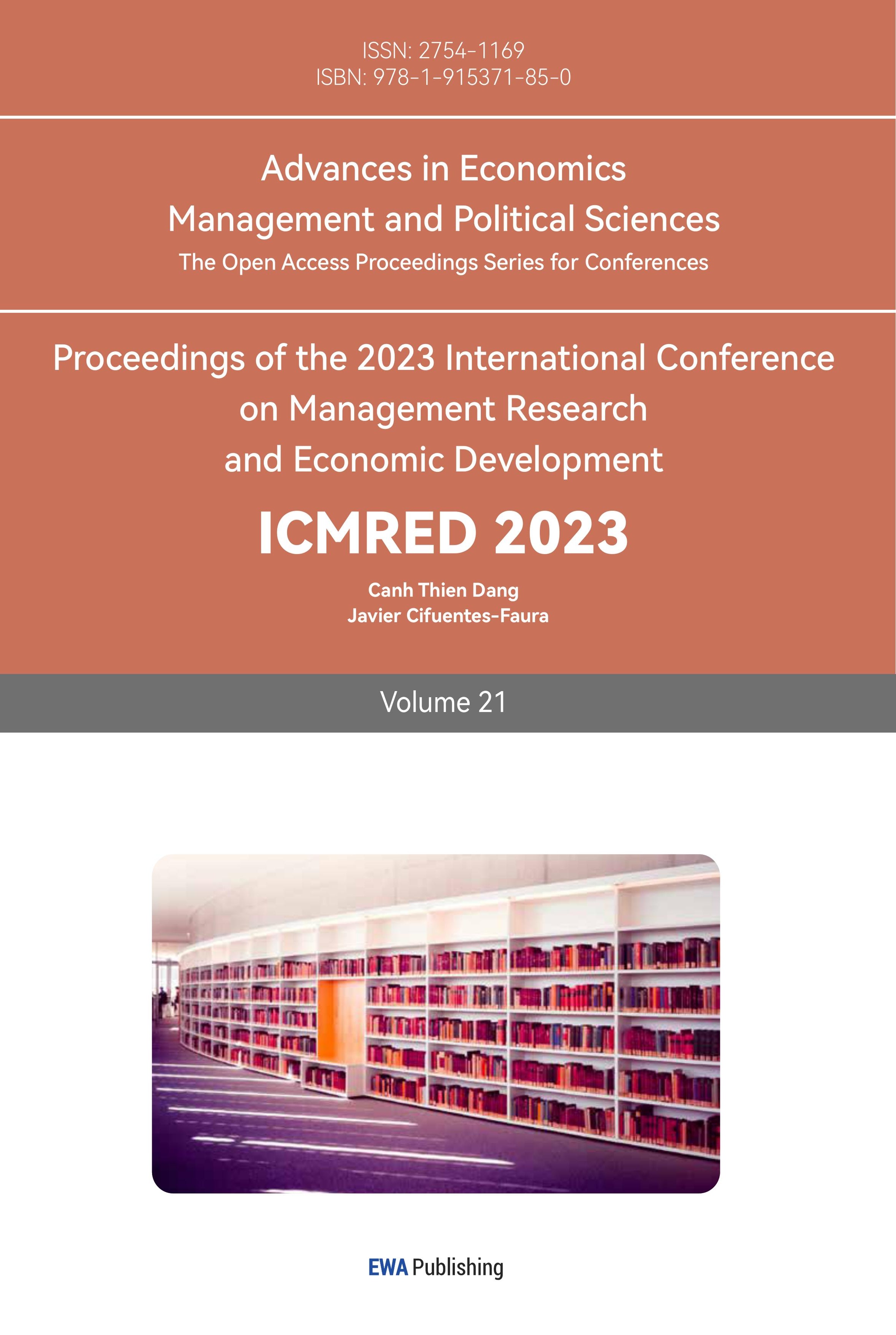References
[1]. Yang Mingduo, Zhang Liangyin. Analysis of the development status of China's fast food industry. Business economy (8), 3 (2010).
[2]. Li Guishu. McDonald’s. Crazy English: Middle School Edition, (14), 36-36 (2003).
[3]. Ji Weiqing & Zhang Lei. Human resource management under the franchise model-McDonald’s inspiration to franchised enterprises in our country. Economic Research Bulletin (06), 40-42 (2006).
[4]. KFC official website. http://www.kfc.com.cn/kfccda/index.aspx, last accessed 2023/2/23.
[5]. Chen Bingqi. McDonald’s and KFC: The secrets of the world's two largest fast food empires. China Economic Press (2006).
[6]. Deng Jinsong. Analysis of the competitive strategy of McDonald’s and KFC. Modern Business (18), 32-33 (2007).
[7]. Peng Hui. Judging from the changes in cultural values in McDonald’s and KFC's advertising in China, its global regionalization strategy. (Doctoral dissertation, University of International Business and Economics) (2011).
[8]. Lin Jianhong, Still novel. Analysis of the competitive advantage of the fast food industry-Comparison between McDonald’s and KFC. Journal of Harbin Vocational and Technical College (2), 2 (2005).
[9]. Yuan Zheng. Analysis of the competitive advantage of the fast food industry-Comparison between McDonald’s and KFC. Chinese and foreign entrepreneurs (7), 46-49 (2003).
[10]. Chen Hong, Xu Huidan. Thinking on the economic competitive relationship of living next to each other--take KFC and McDonald’s as an example. Chinese Business Theory (19), 3 (2016).
Cite this article
Ge,M. (2023). Fast Food Business: Taking McDonald's and KFC for Example. Advances in Economics, Management and Political Sciences,21,130-135.
Data availability
The datasets used and/or analyzed during the current study will be available from the authors upon reasonable request.
Disclaimer/Publisher's Note
The statements, opinions and data contained in all publications are solely those of the individual author(s) and contributor(s) and not of EWA Publishing and/or the editor(s). EWA Publishing and/or the editor(s) disclaim responsibility for any injury to people or property resulting from any ideas, methods, instructions or products referred to in the content.
About volume
Volume title: Proceedings of the 2023 International Conference on Management Research and Economic Development
© 2024 by the author(s). Licensee EWA Publishing, Oxford, UK. This article is an open access article distributed under the terms and
conditions of the Creative Commons Attribution (CC BY) license. Authors who
publish this series agree to the following terms:
1. Authors retain copyright and grant the series right of first publication with the work simultaneously licensed under a Creative Commons
Attribution License that allows others to share the work with an acknowledgment of the work's authorship and initial publication in this
series.
2. Authors are able to enter into separate, additional contractual arrangements for the non-exclusive distribution of the series's published
version of the work (e.g., post it to an institutional repository or publish it in a book), with an acknowledgment of its initial
publication in this series.
3. Authors are permitted and encouraged to post their work online (e.g., in institutional repositories or on their website) prior to and
during the submission process, as it can lead to productive exchanges, as well as earlier and greater citation of published work (See
Open access policy for details).
References
[1]. Yang Mingduo, Zhang Liangyin. Analysis of the development status of China's fast food industry. Business economy (8), 3 (2010).
[2]. Li Guishu. McDonald’s. Crazy English: Middle School Edition, (14), 36-36 (2003).
[3]. Ji Weiqing & Zhang Lei. Human resource management under the franchise model-McDonald’s inspiration to franchised enterprises in our country. Economic Research Bulletin (06), 40-42 (2006).
[4]. KFC official website. http://www.kfc.com.cn/kfccda/index.aspx, last accessed 2023/2/23.
[5]. Chen Bingqi. McDonald’s and KFC: The secrets of the world's two largest fast food empires. China Economic Press (2006).
[6]. Deng Jinsong. Analysis of the competitive strategy of McDonald’s and KFC. Modern Business (18), 32-33 (2007).
[7]. Peng Hui. Judging from the changes in cultural values in McDonald’s and KFC's advertising in China, its global regionalization strategy. (Doctoral dissertation, University of International Business and Economics) (2011).
[8]. Lin Jianhong, Still novel. Analysis of the competitive advantage of the fast food industry-Comparison between McDonald’s and KFC. Journal of Harbin Vocational and Technical College (2), 2 (2005).
[9]. Yuan Zheng. Analysis of the competitive advantage of the fast food industry-Comparison between McDonald’s and KFC. Chinese and foreign entrepreneurs (7), 46-49 (2003).
[10]. Chen Hong, Xu Huidan. Thinking on the economic competitive relationship of living next to each other--take KFC and McDonald’s as an example. Chinese Business Theory (19), 3 (2016).









